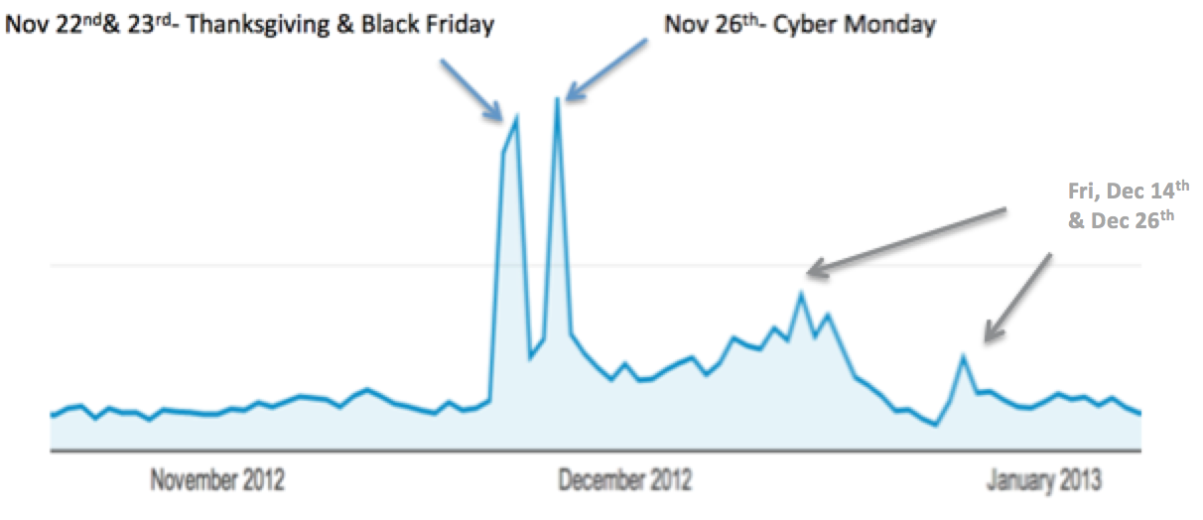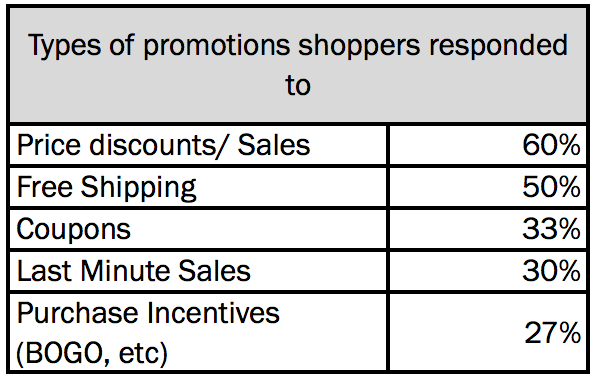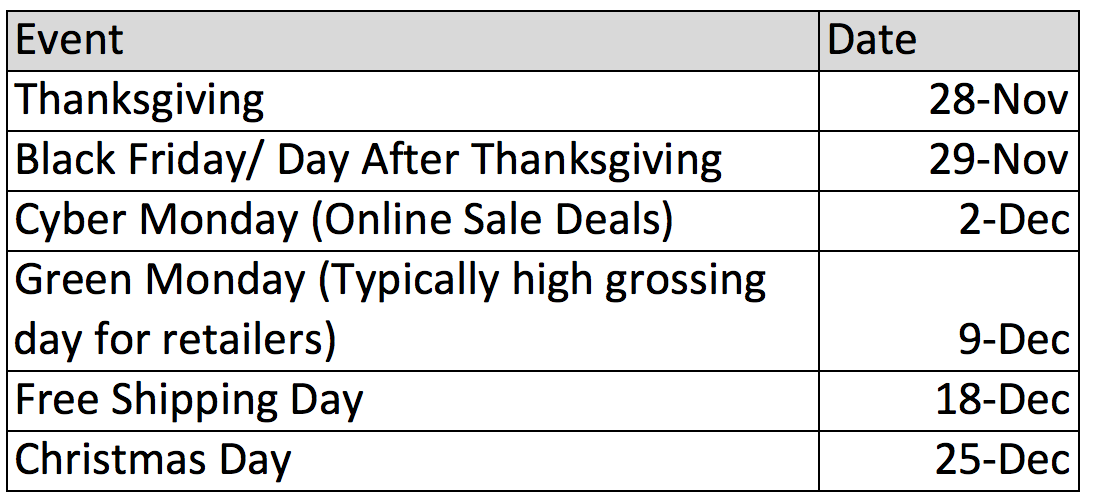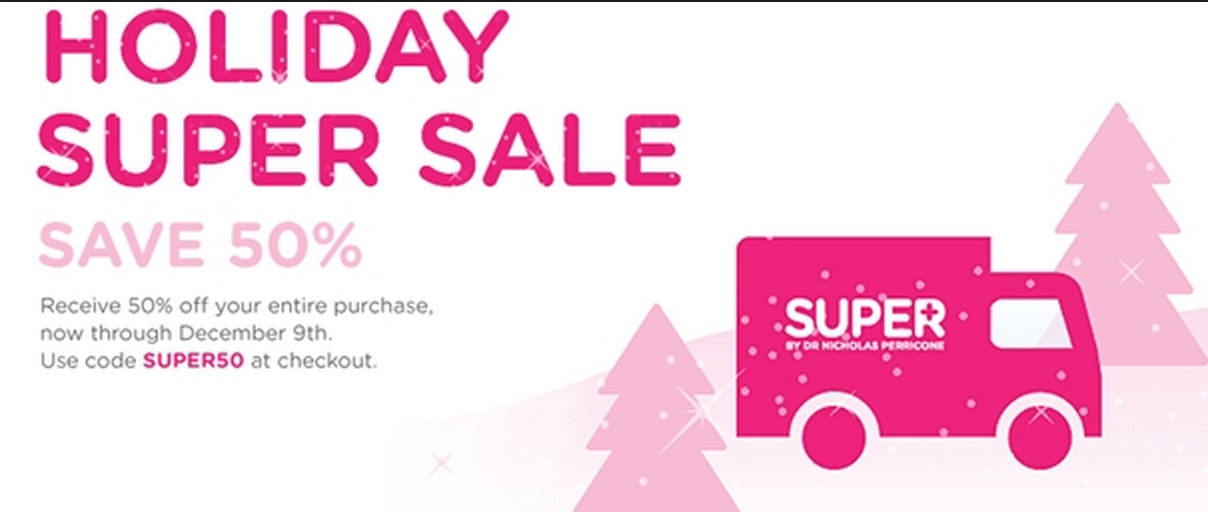We’ve seen the leaves changing, sweatshirts adorned with pumpkins, and so much candy everywhere we turn! While we enjoy the fall, that sneaky holiday season is right behind it! If you’ve not yet begun planning for how to manage your PPC accounts for the holidays, the time is now.
Holiday Strategy
There are myriad best practices on how to effectively prepare for your pre-holiday peak, but most revolve around the weeks preceding Christmas:
Important Dates (Yes, I want you to write these down)
Now it’s time to see what your historical performance shows. Were this days indeed times of higher traffic? An example of one e-comm client with a brick-&-mortar presence as well as an online store saw online conversions peak on expected and perhaps less-expected days:  But what don’t we see? We don’t see a build up to Thanksgiving, nor a solid momentum through early December. Somehow we failed to either a) account for increased traffic with better-allocated budgets or b) seek out more shoppers as the volume of online customers is certainly higher during this window.
But what don’t we see? We don’t see a build up to Thanksgiving, nor a solid momentum through early December. Somehow we failed to either a) account for increased traffic with better-allocated budgets or b) seek out more shoppers as the volume of online customers is certainly higher during this window.
If your e-comm client doesn’t reserve a large chunk of budget for the holiday season, get talking to them STAT. If you want to bring in more traffic, you’re going to need to invest more, and most retailers find that the holidays are the time when people just want to spend, Spend, SPEND!
For accounts who’ve seen it before:
It is a widely recognized best practice to increase your budget starting (at least by) Nov 1st and prepare to continue to increase in the week preceding Thanksgiving, and then continue strong through the end of the pre-Christmas season. If you find that your historical data supports certain shopping days over others, prepare to boost your budget during that period, too.
It will behoove all of you returning folks to not only take a look at last years success but also where you missed out. How was your impression share throughout the holiday months? 
In one example, I can see that this account was extremely restricted by budget over the holiday months. During our top week of the year, we still suffered 88% of our impression share being lost because we just didn’t have enough budget or well-allocated budget to accommodate all the shoppers coming through. How to apply these findings to the year at hand? Examine which campaigns were experiencing the greatest lost impression share. Is there a reason they had this deficit? Sometimes you may have a clear understanding on why your IS may appear bad (but really it’s a highly targeted structure and you don’t want to be bidding on those keywords). However, if your impression share changes drastically during the holiday season, consider tweaking your budgets and bids to get the most you can out of this year’s traffic.
First year in e-comm:
– Overall performance: Prepare to be more aggressive with your bids during the holiday season. You want to really go for more traffic? So do most other retailers. This is going to have a trickle down effect in your average cost-per-click. Watch your average position and impression share shift and adjust your bids accordingly. Don’t forget to keep your quality score in top form to help share some of the load.
– Ad copy: As if I really need to say this, ad copy is your gateway to your customers. If they don’t know about all your fantastic specials, ranging from pre-T-day to Black Friday to Cyber Monday, or simply a countdown approach, reminding shoppers they have “Only 11 Days Left For ‘Last Minute Sale!’”. Regardless of your specific client’s message, it is imperative that you remember to take advantage of your ad copy. Get the new ads in your account and approved early so that as each day approaches you’re ready to activate the latest message.
– Similarly, if you’ve got products that need to move, make sure you’re pushing those products. Location targeting: If you have a storefront or a distribution center with a surplus of certain products, target those areas with the products you’re hoping to move. This is where bid strategies come into play and can serve useful on a short term basis.
Takeaways for old and new
Keyword coverage: You know what people search for throughout the year, but how does this change over the holidays? It’s reputed that online shoppers search by:
- Type of Gift 36% of the time
- Retailer/Shop 38% of the time
- Brands 37% of the time
While this report may add up to 101% (source: Google), we also know that this means your account coverage may rely on a broader coverage during the shopping season. Even creating a holiday-specific campaign gives you the opportunity to expand in ways you’ve resisted in the past. This campaign can then be concluded at the end of the season, to be optimized and resumed the following year.
Whatever your “schtick” is this holiday season, go big or go home! Google supports that when confronted with various shopping incentives, respondents reported that they would take advantage of the following:
–Remarketing: Hopefully this is totes obvi to you at this point, but if you’ve haven’t yet implemented a remarketing strategy go immediately to this tutorial. Do not pass Go, do not collect $200.
If you use Remarketing already, I want to be sure you’re directed to another form: Remarketing for Search / Remarketing Lists for Search Ads.
Remarketing for Search consists of using the remarketing list to target people searching for specific key terms. If your list consists of people who’ve viewed pages about kids skateboarding equipment without converting, you may want to have keywords about skateboarding in your RLSA campaign. This takes someone who may just be price-shopping, surfing various sites with kids’ recreational equipment, and reminds them each time they search a broad term such as “helmet” or “skateboard,” that your site offers these things. The bonus to this is the customized ad copy that can not only pertain to the topic, but to any discount, deal, or coupon you may be offering during the holidays.
–Mobile: 2013 will forever be the year of Enhanced Campaigns and the massive (if not compulsory) integration of mobile traffic into our daily PPC. How will you respond?
The new big idea for mobile is the device-specific savings.
– One strategy involves mobile site-specific savings or codes. Whether it’s a promotional code only found on your mobile site or a coupon that can be scanned in-store through one’s phone, retailers are seeing increased mobile activity as an opportunity to really customize their advertising.
– Also geotargeting your mobile ads with promotional codes or coupons allows for customized engagements between mobile users and your business. The specific application of this targeting may be to use campaigns targeting specific geographic regions (such as Indiana and California) for which you include regionally specific discounts. Below are two example ads that may be shown to users from Indiana and California, respectively, searching “girl’s beginner skateboard”:
INDIANA AD:
CALIFORNIA AD:
The result of this code is a clearly trackable promotion, segmented not only by device but by location and promotion type as well.
Now, this list is in no way exhaustive, as we still have to cover topics such as Dynamic Remarketing, those glorious PLAs, and social media, but it’s a starting point for those of you who have suddenly realized, “Yes, we are in the 6 week countdown” to the holidays. With these initial steps, you should be able to start the push into what could stand to be a fantastic Q4!










